Introduction
In recent years, there has been a rapid increase in the demand for additive-free, fresh-cut fruit (Ma et al., 2017). Although highly convenient, these products are extremely perishable and must be distributed within a very short time period. This has rapidly raised an interest in the search for postharvest methods that are able to maintain quality and prolong the shelf-life while reducing or avoiding the use of synthetic additives (Charles, 2018).
UV-C radiation has long been known for its germicide properties (Graça et al., 2020). These treatments were initially applied for material disinfection, but they subsequently started to be evaluated for direct use on food surfaces (Vicente and Lurie, 2014). UV-C treatments have been reported to control postharvest rots, delay ripening, reduce some physiological disorders, and induce antioxidants (Romanazzi et al., 2016). However, the effects of UV-C radiation are variable and largely dependent on the organ type, species, cultivar, ripening stage, processing degree, and irradiation conditions (Bu et al., 2013; Gayán et al., 2014; Abdipour et al., 2019). Strawberry treatments with UV-C doses ranging between 0,25 and 4,0 kJ m-2 have been reported to improve postharvest quality maintenance (Ortiz-Araque et al., 2019). Cote et al. (2013) highlighted the importance of radiation intensity as a major factor, in addition to the total radiation dose applied. The relevance of considering both the treatment dosage and radiation intensity was also highlighted in UV-B-treated vegetables (Darré et al., 2017), even though both process control variables were rarely reported.
Some studies have reported the benefits of UV exposure in fresh-cut fruits and vegetables (Graça et al., 2020). The number of studies is much more limited when compared to unprocessed commodities. This may be due to the fact that these products are normally subjected to a wet disinfection step. While this may be speculated to decrease the potential benefits of UV-C treatments, it needs to be evaluated in a commodity-dependent manner. A recent report by Li et al. (2019) showed positive results in cut strawberries treated with UV-C radiation. However, in this study, the role of radiation intensity on treatment efficacy was not addressed. The aim of this work was to select the appropriate UV-C radiation dose and intensity conditions for the postharvest treatment of fresh-cut strawberries, as well as to determine their influence on the fruits' physical, chemical, microbiological, and sensory quality.
Materials and methods
Selection of optimal UV-C radiation dose and intensity combination
Strawberries cv. Camarosa produced in greenhouses in La Plata, Argentina, were harvested at commercial maturity (100% red surface color) and transported to the laboratory within 1 h. Fruit selection was performed to eliminate those with physical damage, ripening, or shape defects. The fruits were washed with chlorinated water (NaClO 100 mg L-1, pH 6,5) and cut longitudinally to the main axis in quarters. After cutting, the fruits were washed again and drained to eliminate water excess. They were subjected to the following treatments:
i. Control: unexposed to UV-C light. ii. UV-C low intensity/ low dose: fruit treated with UV-C radiation at an intensity of 9 W m-2 and a dose of 2 kJ m-2. iii. UV-C low intensity/ high dose: fruit treated with UV-C radiation at an intensity of 9 W m-2 and a dose of 4 kJ m-2. iv. UV-C high intensity/ low dose: fruit treated with UV-C radiation at an intensity of 36 W m-2 and a dose of 2 kJ m-2. v. UV-C high intensity/ high dose: fruit treated with UV-C at an intensity of 36 W m-2 and a dose of 4 kJ m-2. The fruit was rotated to ensure even exposure to UV radiation. The irradiation treatments were carried out in a mobile cabinet (1,7 x 0,8 x 0,5) equipped at the top with 12 UV-C lamps (peak emission UV-C at 254 nm, TUV G30T8, 30 W, Philips, Argentina). The distance between the emitting source and the fruit was 30 cm in all cases. The dose was established by varying the treatment times and intensity and modifying the number of lamps on. The UV-C radiation dose was evaluated using a digital UV-C radiometer (Electro Lite LC 300, United States) located at the center of t he irradiation cabinet. After the treatments, the fruits were placed in polyethylene terephthalate trays (10 x 15 x 3 cm) with perforated lids (1 perforation of 1 mm diameter per cm-2). Forty fruit wedges were placed per tray. Four separate trays were analyzed for each treatment, and the whole experiment was performed in duplicate. After 4 days of storage at 4 °C, the fruit was evaluated for decay incidence in order to select the optimal treatment condition.
Effect of selected UV-C treatment in fruit physic-chemical, microbiological, and sensory quality as well as shelf-life
Strawberries cv. Camarosa were harvested, selected, disinfected, and processed as described in the previous section. The berries were subsequently subjected to UV-C irradiation (36 W m-2 intensity, 4 kJ m-2 dose) and packed as indicated above. Forty fruit wedges were placed per tray. Fruit was stored at 4 °C for 7 days. Corresponding controls without UV-C treatment were packaged and stored as described above. At different storage times (0, 4, and 7 days), samples were taken and used for quality evaluation. For chemical analyses, the samples were frozen in liquid nitrogen and stored at -80 °C until use. Three trays were utilized per treatment and storage time, and the whole experiment was performed in duplicate.
Visual Deterioration Index and juice exudate: a Visual Deterioration Index (VDI) was calculated using a hedonic five-point scale (1: no visual damage to 5: serious damage). The attributes evaluated for VDI were the presence of rot and macerated areas, as well as the loss of surface brightness. Exudate juices were determined by weighing the liquid released on each individual tray along storage. The results were expressed in grams per kilogram on a fresh weight basis. Six measurements were made for each treatment and storage time.
Weight loss: the individual trays were weighed throughout the storage period. Weight loss was calculated according to the following equation: Weight loss (%) = 100 x (Pi-Pf)/Pi, with Pi and Pf being the initial weight and the weight at each storage time, respectively. Six measurements were made for each treatment and storage time.
Yeasts and molds plate counts: 50 g of fruit wedges were put in pre-sterilized beakers containing 225 ml of 0,1% w/v peptone. The samples were shaken for 15 min, and two series of dilutions (10-2-10-4) of the washing liquid were prepared. One milliliter of each dilution was loaded on Petri dishes with a YGC medium and incubated at 20 °C for 5 days. The plates showing between 30 and 300 colonies were counted, and the results were expressed as log of colony forming units (CFU) per gram of fresh fruit.
Firmness: fruit firmness was determined by uniaxial puncture tests on a Texture Analyzer (TA.XT2, Stable Micro Systems Texture Technologies, NY, United States) equipped with a 3 mm diameter flat probe. The samples were compressed 2 mm at a speed of 0,5 mm s- 1. The initial slope of the fruit distance curve was calculated. Results were expressed in N mm-1. 60 measurements were done for each treatment and storage time.
Surface color: measurements were done with a chromameter (Minolta CR-400, Japan) equipped with the CIE C illuminant and with a viewing angle of 0° in order to determine the L*, a*, and b* values. Fruit hue (tg-1 b*/a*) and chroma (a* 2 + b* 2)1/2 were calculated. 30 measurements were made for each treatment and storage time.
pH, acidity, and soluble solids: fruit wedges were ground in a mill, and 5 g of the resulting sample were taken to 100 mL with water. The initial pH was measured using a pH meter, and the samples were titrated with 0,1 M NaOH to a pH of 8,2 determined potentiometrically (AOAC, 1980). The results were expressed as mmol H+ kg-1 on a fresh weight basis. For soluble solid (SS) measurement, ground tissue was filtered through a cloth and measured in a self-compensated digital refractometer (HI 96801, Argentina). The results were expressed in %w/w. Six measurements were done for each treatment and storage time.
Phenolic content: fruit phenolic content, which represents the most abundant group in berries (Martinsen et al., 2020), was determined spectrophotometrically in ethanolic extracts according to Singleton et al. (1995). Results were calculated by using chlorogenic acid (CGA) as a standard and expressed as mg CGA equivalents per kilogram on a fresh weight basis. Three extracts were analyzed for each treatment and storage time.
Sensory evaluation: a consumer sensory acceptability test was conducted for control and UV-C treated fruit stored at 4 °C for 7 days. The panel consisted of 50 consumers with an equal proportion of men and women, whose age ranged from 25 to 35 years old. The panelists were asked to score the fruit in a 9-point hedonic scale (1: poor, 9: excellent) for the following attributes: i) freshness, ii) color, and iii) overall acceptability.
Statistical analysis: The experiments were performed according to a factorial design, whose factors were the treatment (experiments 1 and 2) and storage time (experiment 2). The data were analyzed by means of an ANOVA using the InfoStat/L software, version 2018 (Di Renzo et al., 2018).
The model assumptions of homogeneity of variance and normality were tested by means of the Levene and Shapiro-Wilk tests, respectively, and the means were compared with the Fisher test at a significance level of p<0,05.
Results
Selection of optimal UV-C radiation dose and intensity combination
Berries are among the most perishable fruits (Pott et al., 2019). Their high metabolic and softening rates, as well as their decay susceptibility, normally lead to a very brief postharvest life, even under proper refrigeration (Panou et al., 2020; Muley and Singhal, 2020). In the first experiment, the main cause of fruit deterioration during storage was the formation of discrete macerated areas on the fruit surface. This was accompanied in severely rotten fruit by signs of fungal mycelia. All four UV-C treatments significantly reduced the fruit decay relative to the control (Figure 1). The use of UV-C treatments for disease control has already been reported in whole strawberry with doses ranging between 0,25 and 4,00 kJ m-2 (Nigro et al., 2000; Pan et al., 2004). In fresh-cut berries, a recent study has been conducted, with positive effects in terms of decay control in fruit subjected to a UV dose similar to that tested in this research (Li et al., 2019). However, in this study, the influence of different radiation intensities for a similar dose were not evaluated; the UV-C treatments at the lowest dose already controlled rot incidence. Under this UV-C dosage, no impact of the irradiance used was found in terms of treatment efficacy. On the contrary, differences in decay control were found between UV-C doses when high radiation intensity was applied. The UV-C treatment combining high intensity and high dosage (36 W m-2 and 4 kJ m-2) turned out to be the most effective condition for decay control. In strawberries, Cote et al. (2013)) reported that a high UV-C radiation intensity improves decay control, although this work was done in unprocessed, less mature, and unwashed berries. Moreover, these authors did not assess the influence of different dose-intensity combinations. Based on the results obtained, the high dose-high intensity UV-C treatment (4 kJ m-2 - 36 W m-2) was selected to further characterize the impact on fruit physicochemical, microbiological, and sensory properties during storage.
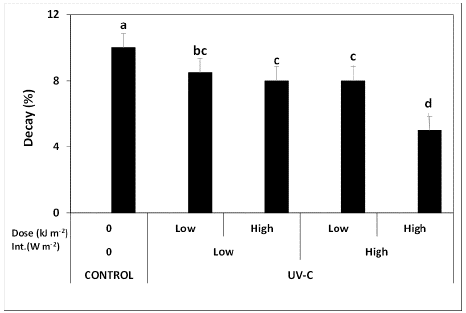
Source: Authors
Figure 1 Selection of optimal UV-C treatment conditions (dose and intensity) based on decay control for fresh-cut strawberries stored at 4 °C for 4 d. Low intensity: 9 W m-2; High intensity: 36 W m-2; Low dose: 2 kJ/ m-2; High dose: 4 kJ m-2. Different letters indicate differences according to Fisher's test with a significance level of p<0,05.
Effect of selected UV-C treatment on fruit physicochemical, microbiological, and sensory quality as well as shelf-life
The most prevalent deterioration symptoms during storage were the loss of surface brightness and the formation of rotten areas. Strikingly, tissue decay was most common in the outer zone of the receptacle (pigmented sides) than in the radial (white, pink) cutting region. This differs from what has been reported in other fresh-cut products, in which the cutting zones become the most susceptible areas (Rodoni et al., 2017). One plausible and simple explanation could be that the internal radial fruit region still contains unripe tissues, and that the protective effect of this maturity factor on decay susceptibility is more relevant and caused by the removal of natural barriers through cutting. Moreover, control and UV-C treated fruits showed clear differences regarding the Visual Deterioration Index (VDI). After 4 days of storage, the VDI was already significantly lower in UV-C-irradiated fruit (Figure 2).
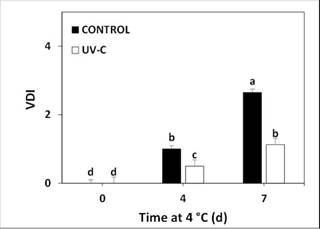
Source: Authors
Figure 2 Visual Deterioration Index (VDI) in control or UV-C-treated (36 W m-2 radiation intensity and 4 kJ m-2 radiation dose) fresh-cut strawberry, stored at 4 °C for 0, 4, and 7 days. Different letters indicate significant differences according to Fisher's test with a significance level of p<0,05.
The effect became even greater after 7 days at 4 °C. The VDI of UV-C treated berries after one week was indeed comparable to that found in control fruits stored for just 4 days. These differences are relevant for very perishable commodities such as fresh-cut strawberry, which rarely lasts more than 7 days.
Another clear difference found between control and UV-C treated fruits was the exudates of fruit juices. After 7 days of storage and indirectly indicating greater cell rupture, control fruits released 20 times more juices in the trays than the corresponding UV-C-treated berries (Figure 3).
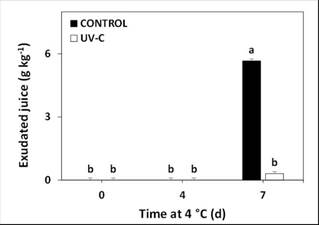
Source: Authors
Figure 3 Juice exudate in control or UV-C treated (36 W m-2 radiation intensity and 4 kJ m-2 radiation dose) fresh-cut strawberry, stored at 4 °C for 0, 4, and 7 days. Different letters indicate significant differences according to Fisher's test with a significance level of p<0,05.
To understand whether the responses in this case were due to a germicide response, we tested the changes in fungal CFU in control and treated fruits immediately after UV exposure as well as during storage. The main fungi that have been associated with strawberry postharvest decay include Botrytis and Rhizopus (Nigro et al., 2000; Agyare et al., 2020). Yeasts have been also reported to cause soft rots in fresh-cut commodities (Graça et al., 2020). Immediately after irradiation, no changes in yeast and mold counts were found (Figure 4).
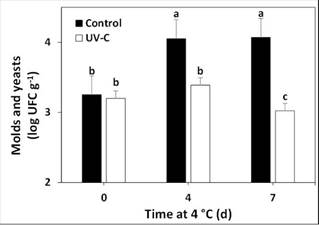
Figure 4 Molds and yeasts count in control or UV-C-treated (36 W m-2 radiation intensity and 4 kJ m-2 radiation dose) fresh-cut strawberry, stored at 4 °C for 0, 4, and 7 days. Different letters indicate significant differences according to Fisher's test with a significance level of p<0,05.
However, after both 4 and 7 days of storage at 4 °C, UV-C-treated fruits presented lower CFU g-1 than the control. This indicates that the observed impact on fruit decay was not due to a germicidal response. Instead, it might have been caused either by germistatic effects on the pathogen side, by ripening modulation and hermetic responses on the fruit side, or by their combinations. While working with whole strawberries, Pan et al. (2004) reported that UV-C treatments at a dose similar to that used here reduced Botrytis and Rhizopus conidia germination without affecting their viability, and Pombo et al. (2010) described the induction of genes that code for antimicrobial enzymes.
UV-C-treated fruit showed lower weight loss than the control at the end of storage (Figure 5). Lamickanra et al. (2005) suggested that irradiation of fresh-cut Galia melon partially dehydrated the fruit epidermis and prevented subsequent water loss. Rodoni et al. (2012) suggested that, by favoring the cross-linking of wall proteinaceous and phenolic components, UV exposure may increase fruit resistance to dehydration. Although further studies would be necessary to establish the mechanisms involved, results show that the UV-C treatments applied herein were also beneficial to prevent tissue dehydration.
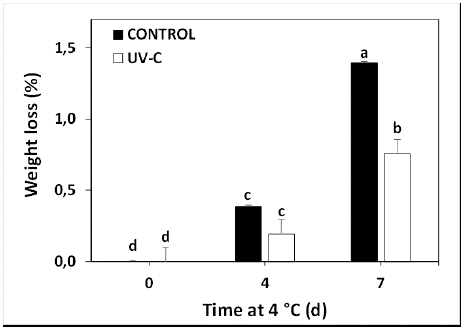
Source: Authors
Figure 5 Weight loss in control or UV-C-treated (36 W m-2 radiation intensity and 4 kJ m-2 radiation dose) fresh-cut strawberry, stored at 4 °C for 0, 4, and 7 days. Different letters indicate significant differences according to Fisher's test with a significance level of p<0,05.
Rapid softening is another relevant issue in stored berries. After 4 days of storage, control fruits already showed a drop in tissue resistance to compression (Figure 6). Higher values were found in UV-C-treated berries, also indicating a protective effect on texture deterioration. These differences were observed until the end of the storage period. The positive effect that UV-C irradiation had on fruit texture is remarkable. In fact, UV-C-treated berries showed no softening even after 7 days of storage. The greater firmness of the irradiated fruits relative to the control could be related to a retardation of cell wall disassembly. Previous works have demonstrated that UV-C radiation may delay fruit softening (Rodoni et al., 2017; Bu et al., 2013; Adipour et al., 2019). This effect has been linked both to an inhibitory effect on fruit pectolytic enzymes (Ortiz-Araque et al., 2019).
To determine if exposure to UV radiation caused modifications in other relevant quality attributes, the impact on color, acidity, soluble solids content, and phenolic content was determined (Table 1). Overall color changes throughout storage were slight since it started with fruits in a state of advanced maturity. However, on the last day of sampling, treated fruit showed a higher lightness (L*) and Hue angle, thus pointing to a delay in surface reddening. Fruit pH, acidity, soluble solids content showed no major variation throughout storage or in response to UV-C exposure. This is in line with the results reported in the literature (Cote et al., 2013; Nimitkeatkai and Kulthip, 2016; Safitri et al., 2015). Finally, while analyzing the content of total phenolic compounds, an increasing trend was found with storage. Regarding the impact of UV-C, after 4 days, no differences were observed between control and treated fruits. At the last day of sampling UV-C treated fruit showed a slight delay in phenolic compound accumulation. This differs from previous works, where the use of UV-C radiation elicited antioxidant compounds (Li et al., 2019; Esua et al., 2019; Duarte-Sierra et al., 2019; Michailidis et al., 2019). The results of this research show that the inductive effect of UV-C of phenolic compound biosynthesis is highly dependent on irradiation conditions, which likely also occurs during the product processing stage. The reduction in phenolic content found in the last sampling point is of little or no relevance from an antioxidant intake point of view.
Table 1 Lightness (L*), Hue, pH, acidity, SS, and phenolic content of control and UV-C-treated (36 W m-2 radiation intensity and 4 kJ m-2 radiation dose) fresh-cut strawberry, stored at 4 °C for 7 days.* Different letters indicate significant differences according to Fisher's test with a significance level of p<0,05.
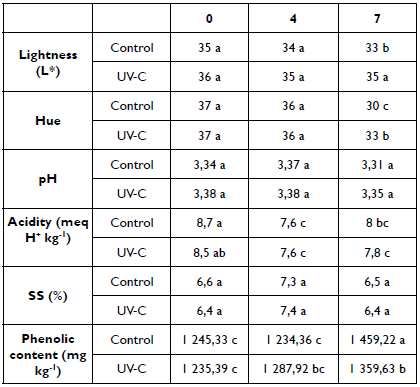
Source: Authors
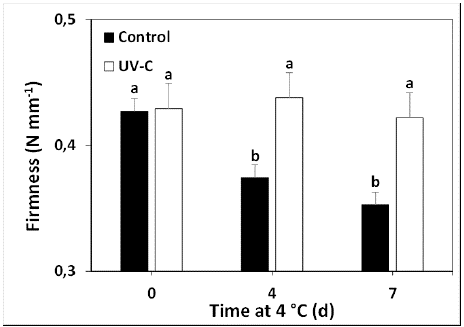
Source: Authors
Figure 6 Firmness in control or UV-C-treated (36 W m-2 radiation intensity and 4 kJ m-2 radiation dose) fresh-cut strawberry, stored at 4 °C for 0, 4, and 7 days. Different letters indicate significant differences according to Fisher's test with a significance level of p<0,05.
We finally conducted a consumer sensory test for three relevant attributes for fruit purchase (freshness, color, and overall acceptability) (Figure 7). Regardless of the attributes, UV-C-treated berries showed higher scores than the control.
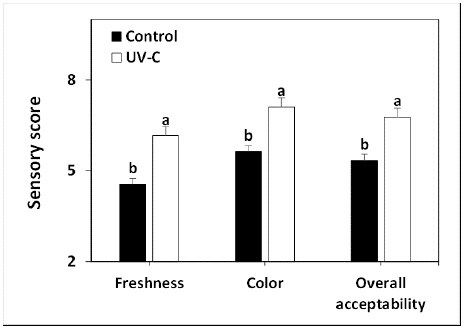
Source: Authors
Figure 7 Sensory scores for freshness, color, and overall acceptability in control or UV-C treated (36 W m-2 radiation intensity and 4 kJ m-2 radiation dose) fresh-cut strawberry, stored at 4 °C for 7 days. Different letters indicate significant differences according to Fisher's test with a significance level of p<0,05.
Conclusions
In this work, we first selected a proper combination of radiation dose and intensity for postharvest treatment of fresh cut strawberry. Treatments at the highest dose (4 kJ m-2) and intensity (36 W m-2) showed the greatest benefits in terms of fruit decay control and shelf-life extension. UV-C-treated berries showed reduced deterioration, juice exudates, weight loss, softening, and yeasts and mold counts, as well as higher scores in consumer sensory tests. The treatments did not cause major changes in fruit pH, acidity soluble solids, or phenolic compounds. After one week, UV-C-treated berries reported a similar deterioration to that of control fruit upon 4 days. The overall results suggest that short UV-C treatment could be useful to supplement cold storage, extending the shelf-life of fresh-cut strawberries.















